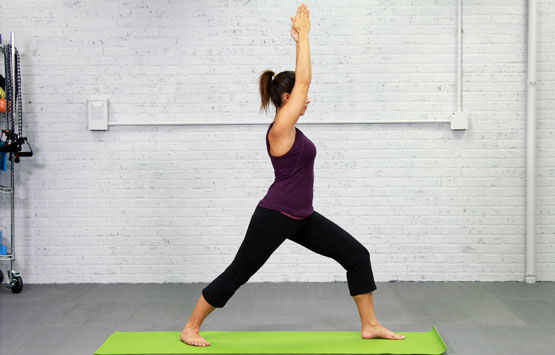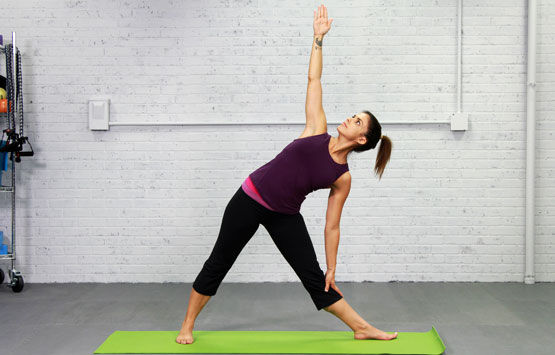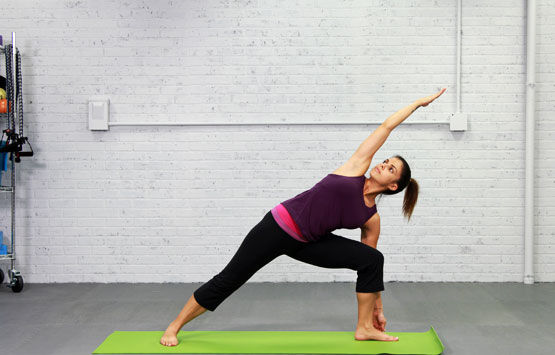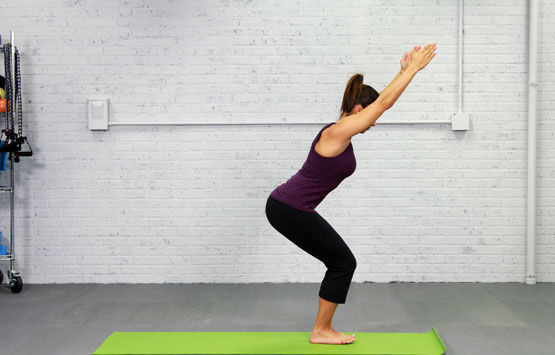School, marriage, balancing work with family – a hectic schedule is the norm for many women. And oftentimes, if there isn't enough time in the day, the first thing to go is their workouts.
As a trainer, that can be challenging. Throw in pregnancy, menopause and other physiological changes women experience and getting them to focus on exercise can be downright frustrating.
The good news is ACE Exercise Physiologist and Experienced Registered Yoga Teacher (E-RYT) Jessica Matthews has found a way you can help them de-stress and relieve physical discomforts they may experience in different life stages. Making your women say “om” in these five simple yoga poses can address discomfort in the first trimester of pregnancy, hot flashes during menopause and bone loss associated with osteoporosis, according to studies by the Mayo Clinic and Prevention magazine.
Warrior I (Virabhadrasana 1)

Stand with your feet hip-width apart, toes pointing forward and arms relaxed down by your sides. Pull shoulder blades down and back without arching your lower back, and engage your abdominal muscles to stabilize the spine. Take a deep inhale, and as you exhale, step forward with the right foot while raising the arms toward the ceiling, palms facing each other. Keep the right foot pointed forward and turn the left foot out to the side 45-60 degrees. Align the left heel with the right heel. Lunge forward into the right leg while keeping the back leg straight and strong. As you lower your hips toward the floor, allow the right knee to stack over the right ankle and continue to keep the back heel firmly pressed into the ground. Square your shoulders and hips to the front of the mat. Lift your rib cage without arching your lower back, and relax the shoulders down away from ears. Hold for five slow breaths (about 30 seconds) and repeat on the other side.
Warrior II (Virabhadrasana 2)

Stand with your feet together. Exhale and step the feet 3½ to 4 feet apart. Raise your arms parallel to the floor and reach actively out to your sides with shoulder blades wide and palms down. Turn the right foot in slightly and the left foot out 90 degrees, and align the left heel with the right heel. Exhale and bend the left knee over the left ankle so that the shin is perpendicular to the floor, and allow the knee to open out slightly toward the pinky toe. Anchor by strengthening the right leg and pressing the outer edge of the right foot firmly into the floor. As you bend into the left leg, stretch your arms out parallel to the floor, with the palms facing down, while keeping the shoulders stacked directly over the pelvis and the torso tall. Tuck your tailbone slightly, turn your head to the left and gaze softly over your fingers. Hold for five slow breaths and repeat on the other side.
Extended Triangle (Utthita Trikonasana)

Stand with your feet together. Exhale and step the feet 3½ to 4 feet apart. Raise your arms parallel to the floor and reach actively out to your sides with the shoulder blades wide and palms down. Turn your left foot in slightly to the right and your right foot out 90 degrees. Align the right heel with the left heel. Firm the thighs and turn your right thigh slightly outward, so that the center of the right knee is in line with the center of your right ankle. Exhale and extend the torso to the right directly over right leg, bending from the hip, not the waist. Anchor by strengthening the left leg and pressing the outer edge of the left foot firmly into the floor. Rotate the torso to the left, keeping your two sides equally long. Let your left hip come slightly forward and lengthen your tailbone toward your back heel. Rest your right hand on your shin, ankle or the floor outside your right foot--whatever is possible without compromising the length of your torso. Stretch your left arm toward the ceiling in line with the tops of your shoulders while keeping your head and neck neutral. Gaze up at your fingers if comfortable. Hold for five slow breaths and repeat on the other side.
Extended Side Angle (Utthita Parsvakonasana)

Stand with your feet together. Exhale and step the feet 3½ to 4 feet apart. Raise your arms parallel to the floor and reach actively out to your sides with shoulder blades wide and palms down. Turn your left foot in slightly to the right and your right foot out 90 degrees. Align the right heel with the left heel. Roll the left hip slightly forward and to the right while rotating your upper torso back to the left. Anchor the left heel into the floor, then exhale and bend your right knee over the right ankle so that the shin is perpendicular to the floor, and allow the knee to open out slightly toward the pinky toe. Keeping the shoulder blades pulled down and back, extend your left arm straight up toward the ceiling, and turn the left palm to face your head. Inhale to reach the arm over the back of your left ear, palm facing the floor. Lengthen the left side of your body through the fingertips, and turn your head to look at your left arm. Release the right shoulder away from your ear. Exhale and lay the right side of your torso down onto your right thigh. Press your right fingertips on the floor outside your right foot while actively pushing the right knee back against the inner arm. The inside of your right thigh should be parallel to the long edge of your mat. Hold for five slow breaths and repeat on the other side.
Chair Pose (Utkatasana)

Stand with your feet together. Inhale and raise your arms over your head, perpendicular to the floor with the palms facing one another. Exhale and bend knees slightly, taking the thighs as close to parallel with the floor as possible. As the torso leans slightly forward over the thighs, continue to keep the inner thighs parallel to each other and press down through heels. Tuck the tailbone toward the floor and in to keep your back long. Hold for five slow breaths.
“These specific yoga poses can be particularly beneficial to women in the first trimester of pregnancy and those experiencing menopause and osteoporosis because they are weight-bearing exercises that help strengthen muscles, increase muscle mass, improve or preserve bone mineral density and enhance balance to help reduce the risk of falling,” Matthews explains. “Because these exercises are all done in a standing position and focus heavily on the muscles of the lower extremities, they translate much more effectively to activities of daily living in comparison to exercises performed in a seated position.”
Learn more about adapting your approach to address specific challenges and physiological changes women experience by exploring our new women-focused continuing education bundle.
“Connecting with Women at Every Stage” includes the following, a total of 1.0 CECs:
- Pre- and Post-Natal Exercise (Book & DVD)
- Fitness and Menopause (Online Course)
- Exercise and Osteoporosis (Online Course)
- Fibromyalgia and Exercise (Online Course)
- Fitting Fitness Into Parenthood (Online Course)